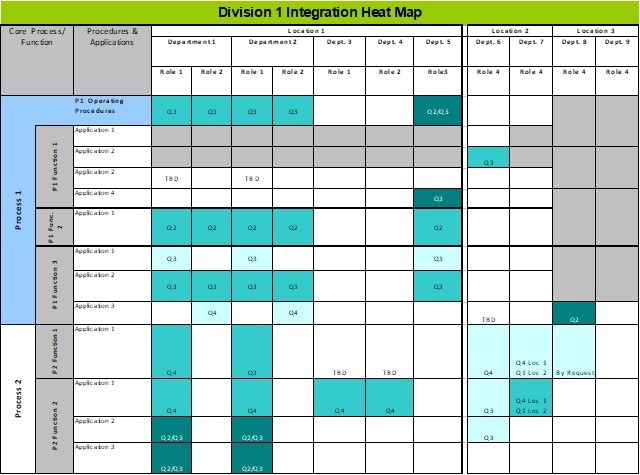On a recent new technology implementation for a major, global corporation our consultants quickly realized the new system was actually one of 60 initiatives that were being launched over an 18-month period. Each individual project had its own project team and although there were interdependencies between the initiatives, the project teams were completely unaware of what the others were doing. 
When we sat down with Senior Leadership, we asked which projects should take priority over the others. Their answer? “They are all important!” When we dug a little deeper, we realized Senior Management really had no big picture as to how many initiatives were actually happening, where resources needed to be allocated…when, or what the cumulative impacts of all the changes were going to be across each department.
This scenario is not that uncommon. You may have the same situation in your own organization, with multiple projects affecting various departments at the enterprise, functional and departmental levels. Your own Senior Leaders may be unable to set project priorities or even sequence changes because every project is given the same weight of importance without considering the big picture. Targets are likely experiencing huge disruption because numerous changes are occurring at the same time. When there is this much going on, it’s no surprise that “organizational stress” is slowing down both adoption and value realization.
The Value of Heat Mapping
In the example above, our change management consultants knew a Heat Map would be extremely useful. Simply defined, a Heat Map is a comprehensive, visual depiction of where, when and how individual stakeholders (both Sponsors and Targets) will be impacted by a change. A Heat Map shows:
- Who’s impacted by each change
- By how much
- When the impact will be felt
- Where the impact will be felt
In short, a Heat Map is a powerful, but underutilized, tool that provides an accurate look at the big picture of what is going on, when and where. Most importantly, Heat Maps can help Senior Leaders make better decisions on how to sequence changes and how to allocate resources across the entire portfolio of change.
Heat Maps Are Fit for Purpose
There is no one way to build a Heat Map. There is no one template that will meet the need of every situation. To show you the diversity, here are two example Heat Maps our consultants have created for clients:
Sample #1:
This simple Heat Map was used to depict the timing and impact of several planned software integrations on various departments across the organization. It is color coded based on the level of impact. Red indicates the highest amount of effect, green the lowest.

Sample #2:
This section of a much more complex Heat Map was created to illustrate the impact of process and technology changes across multiple users in several different locations. Color coding was used to highlight the different process changes and levels of impact on user groups. As the predicted level of disruption went up, the color in the box became a darker shade of green.

Heat Mapping and the AIM Change Management Methodology
Once a Heat Map is created it is a powerful communication tool for discussions between Change Agents and Sponsors. The Heat Map can be used to communicate current changes across users and locations and to better coordinate sequencing across project lines. This helps minimize impacts on locations and plan for shifts in production. In the long term, Heat Maps can be used for strategic portfolio management, staffing plans and Communication Plans.
The Heat Map should be posted somewhere so that everyone involved in the project including, Change Agents, Sponsors and Targets can see it. This big picture not only ensures everyone understands who, what, when and how a change is happening; it can actually help predict potential personal and cultural barriers to the change. From this information, the principles of the AIM Change Management Methodology can be applied to develop strategies and tactics to minimize the risks.
For example, when Defining the Change, a Heat Map can help set the stage for exactly what is going to happen…when. While Generating Sponsorship, a Heat Map gives Sponsors a clear vision of the impact of each change on their direct reports. This, in turn, helps Change Agents and Sponsors create Communication and Reinforcement Plans. Heat Maps can also be used to predict how much Resistance will be felt and how and when Readiness needs to take place.
Heat Mapping is not a quick process; it takes time to create and maintain them. Still, Heat Maps are a powerful tool to facilitate better communication, decision making and planning. If you are interested in assistance on using Heat Mapping on your project, contact us at info@imaworldwide.com.


